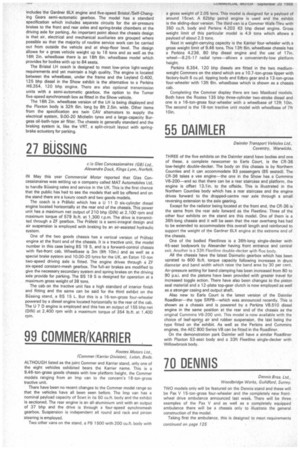79 BRISTOL
Page 123

Page 124

If you've noticed an error in this article please click here to report it so we can fix it.
Bristol Commercial Vehicles Ltd., Bath Road, Brislington, Bristol 4.
TVVO exhibits are on the Bristol stand, one a VRT chassis and the other a bodied version of the LH underfloor-engined vehicle. The latter has a Plaxton body and is built to the order of Golden Miller Coaches.
Bristol introduced the VR at the last Commercial Motor Show and since then has developed the model being exhibited this year. The T in the chassis type indicates a transverse rear engine as against an L which was the original design with the power unit located on the offside of the chassis in a longitudinal position behind the rear wheels. The VRT is said to be currently more acceptable to operators because it meets the requirements of the Grants Scheme for standardized buses whereas the VRL would need special consideration. Even so the VRL is doing very well overseas.
The actual model exhibited by Bristol is the VRT/SL which has a wheelbase of 16ft 2in. for an overall chassis length of 29ft 11.25in. This particular chassis will accommodate a 30ft 5in. long doubledeck body with 70/77 seats. The specification of the Show chassis includes the Gardner 6LX engine and five-speed Bristol /Self-Changing Gears semi-automatic gearbox. The model has a standard specification which includes separate circuits for the air-pressure brakes to the front and rear axles and spring-brake chambers at the driving axle for parking. An important point about the chassis design is that air, electrical and mechanical auxiliaries are grouped where possible so that the majority of routine service work can be carried out from outside the vehicle and at shop-floor level. The design allows for a gross vehicle weight up to 16 tons and as well as the 16ft 2in. wheelbase there is an 18ft 6in. wheelbase model which provides for bodies with up to 84 seats.
The Bristol LH coach is designed to meet low-price light-weight requirements arid yet maintain a high quality. The engine is located between the wheelbase, under the frame and the Leyland 0.400, 125 bhp diesel in the Show exhibit is the alternative to a Perkins 116.354, 120 bhp engine. There are also optional transmission units with a semi-automatic gearbox, the option to the Turner five-speed synchromesh box as fitted in the Show vehicle.
The 16ft 2in. wheelbase version of the LH is being displayed and the Plaxton body is 32ft 6in. long by 8ft 2.5in. wide. Other items from the specification are twin CAV alternators to supply the electrical system, 9.00-20 Michelin tyres and a large-capacity Burgess oil-bath-type air filter. The chassis is generally standard and the braking system is, like the VRT, a split-circuit layout with springbrake actuators for parking.


















































































































































































































































































































































































